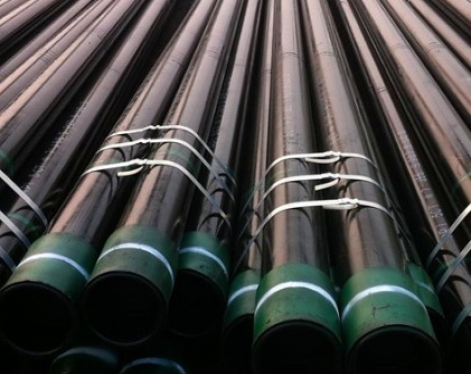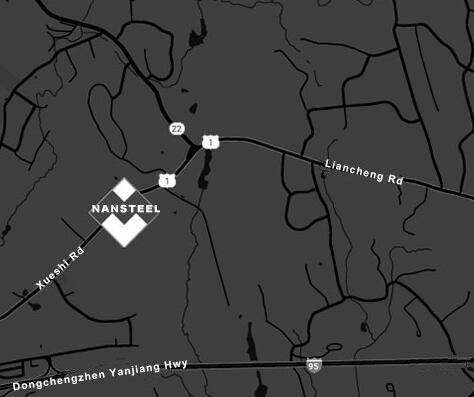OCTG is the abbreviation of Oil Country Tubular Goods, it mainly refers to the piping products that are applied in oil and gas production (drilling activities). OCTG pipe is normally manufactured based on API or related standard specifications. It could also be taken as a collective name for Drill pipe, Steel Casing Pipe and Tubing pipe, Couplings, Connections, and Accessories, used in petroleum industries both onshore and offshore.
OCTG drill pipe – pipe for drilling
Drill pipe is a heavy, seamless pipe that rotates the drill bit and circulates drilling fluid. It enables the drilling fluid to be pumped down through the drill bit and then returned to the surface through the annulus. Drill pipe is extremely strong, capable of withstanding axial tension, high torque, and significant internal pressure, and plays a vital role in oil well tubular services.
In most cases, "drill pipe" refers to durable steel pipe that meets the requirements of API 5DP and API SPEC 7-1.
The "annulus" in an oil well refers to the space between the casing and the drill pipe, or between any pipe and surrounding tubulars. This space allows the drilling fluid to circulate within the well. Therefore, when we talk about heavy-duty oil well tubulars, we are essentially referring to drill pipe.
OCTG steel caing pipe-stabilize the wellbore
Steel casing pipe is an essential component in well construction, especially in the oil and gas industry. It is used to line the borehole drilled into the ground for oil extraction. Much like drill pipe, casing can also resist axial tension. These large-diameter pipes are lowered into the borehole and secured with cement. Once in place, they must withstand their own weight, the external pressure of surrounding rock, and the internal pressure of circulating fluids. Properly cemented casing supports the drilling process in several key ways:
1. Structural Support: Casing stabilizes the wellbore, prevents weak formations from caving in, and ensures the borehole does not collapse during drilling or production.
2. Isolation: It seals off different geological layers, preventing fluid migration between formations and protecting water-bearing zones from contamination.
3. Protection: Casing provides a smooth inner wall for production equipment, shields the well from outside contaminants, and helps maintain the purity of the extracted resources. It also blocks high-pressure zones from reaching the surface, reducing fluid loss in production zones.
4. Facilitating Production: It makes room for production tubing and other equipment needed to bring oil or gas to the surface.
Casing pipes are manufactured from steel in a wide range of sizes and grades to meet different well conditions. As one of the most heavy-duty elements of OCTG, casing is vital to the safety and efficiency of drilling operations.

OCTG Tubing Pipe – transporting oil and gas to the surface ground
In oil and gas operations, tubing pipe plays a key role in production. It is installed inside the well to carry fluids—such as crude oil, natural gas, or water—from the producing formation up to the surface. Unlike casing or drill pipe, tubing is generally lighter and simpler in design. It usually comes in lengths of about 30 feet (9 meters) and has threaded connections at both ends for easy assembly. Once drilling is complete, tubing provides the direct channel through which hydrocarbons flow to processing facilities.
Some of the main characteristics and functions of tubing include:
Fluid Transport: Tubing forms the pathway that brings produced fluids from the reservoir to the surface for treatment and storage.
Smaller Diameter: Compared to casing, tubing has a smaller diameter, which not only makes it easier to handle during installation but also helps maintain efficient flow rates.
Pressure Resistance: Though smaller, tubing is built to withstand production pressures and ensure reliable, safe transport of fluids.
Installation and Maintenance: Tubing is set inside the casing and can be pulled out or replaced when needed, making it practical for well maintenance and repair.
Production Efficiency: By selecting the right material and design, tubing can be optimized for different production environments, improving both the output and longevity of the well.
Conclusion
The proper application of OCTG pipes is directly related to the safety and economic efficiency of oil and gas extraction. Casing strengthens the wellbore, tubing ensures oil and gas flow, and drill pipe transmits power; these three components work together to form the "iron skeleton" of the drilling project. In actual selection, considering operating conditions and international standards (such as API and ISO) can maximize the performance of each type of pipe and safeguard energy extraction.
Read more: OCTG pipe meaning
OCTG drill pipe – pipe for drilling
Drill pipe is a heavy, seamless pipe that rotates the drill bit and circulates drilling fluid. It enables the drilling fluid to be pumped down through the drill bit and then returned to the surface through the annulus. Drill pipe is extremely strong, capable of withstanding axial tension, high torque, and significant internal pressure, and plays a vital role in oil well tubular services.
In most cases, "drill pipe" refers to durable steel pipe that meets the requirements of API 5DP and API SPEC 7-1.
The "annulus" in an oil well refers to the space between the casing and the drill pipe, or between any pipe and surrounding tubulars. This space allows the drilling fluid to circulate within the well. Therefore, when we talk about heavy-duty oil well tubulars, we are essentially referring to drill pipe.
OCTG steel caing pipe-stabilize the wellbore
Steel casing pipe is an essential component in well construction, especially in the oil and gas industry. It is used to line the borehole drilled into the ground for oil extraction. Much like drill pipe, casing can also resist axial tension. These large-diameter pipes are lowered into the borehole and secured with cement. Once in place, they must withstand their own weight, the external pressure of surrounding rock, and the internal pressure of circulating fluids. Properly cemented casing supports the drilling process in several key ways:
1. Structural Support: Casing stabilizes the wellbore, prevents weak formations from caving in, and ensures the borehole does not collapse during drilling or production.
2. Isolation: It seals off different geological layers, preventing fluid migration between formations and protecting water-bearing zones from contamination.
3. Protection: Casing provides a smooth inner wall for production equipment, shields the well from outside contaminants, and helps maintain the purity of the extracted resources. It also blocks high-pressure zones from reaching the surface, reducing fluid loss in production zones.
4. Facilitating Production: It makes room for production tubing and other equipment needed to bring oil or gas to the surface.
Casing pipes are manufactured from steel in a wide range of sizes and grades to meet different well conditions. As one of the most heavy-duty elements of OCTG, casing is vital to the safety and efficiency of drilling operations.

OCTG Tubing Pipe – transporting oil and gas to the surface ground
In oil and gas operations, tubing pipe plays a key role in production. It is installed inside the well to carry fluids—such as crude oil, natural gas, or water—from the producing formation up to the surface. Unlike casing or drill pipe, tubing is generally lighter and simpler in design. It usually comes in lengths of about 30 feet (9 meters) and has threaded connections at both ends for easy assembly. Once drilling is complete, tubing provides the direct channel through which hydrocarbons flow to processing facilities.
Some of the main characteristics and functions of tubing include:
Fluid Transport: Tubing forms the pathway that brings produced fluids from the reservoir to the surface for treatment and storage.
Smaller Diameter: Compared to casing, tubing has a smaller diameter, which not only makes it easier to handle during installation but also helps maintain efficient flow rates.
Pressure Resistance: Though smaller, tubing is built to withstand production pressures and ensure reliable, safe transport of fluids.
Installation and Maintenance: Tubing is set inside the casing and can be pulled out or replaced when needed, making it practical for well maintenance and repair.
Production Efficiency: By selecting the right material and design, tubing can be optimized for different production environments, improving both the output and longevity of the well.
Conclusion
The proper application of OCTG pipes is directly related to the safety and economic efficiency of oil and gas extraction. Casing strengthens the wellbore, tubing ensures oil and gas flow, and drill pipe transmits power; these three components work together to form the "iron skeleton" of the drilling project. In actual selection, considering operating conditions and international standards (such as API and ISO) can maximize the performance of each type of pipe and safeguard energy extraction.
Read more: OCTG pipe meaning
Previous:Carbon Steel Plate Thickness









